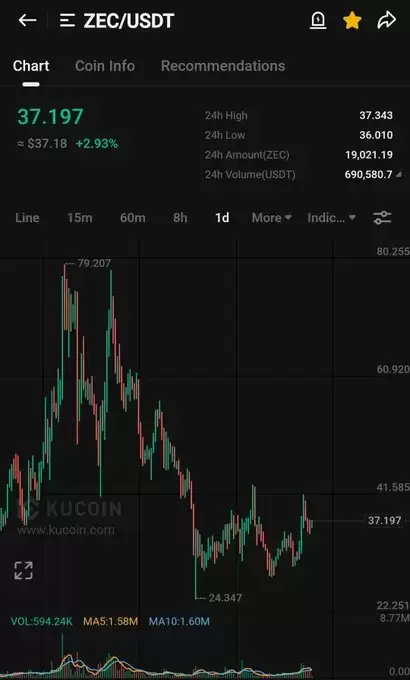| # | Exchange | Pairs | Price | Volume (24h) | Volume (%) | Confidence | Liquidlity Score | Earn |
|---|---|---|---|---|---|---|---|---|
| {{ index+1+((marketpage-1)*marketpagesize) }} |
| {{val.marketPair}} | ${{ decimal(val.price,true) }} | {{val.volume24h}} | {{val.volumePercent}}% | Low Moderate High | {{val.effectiveLiquidity}} | Details |
Showing {{ marketoffsetleft }}-{{ marketoffsetright }} ( in total {{ markettotal }})
Show rows
About Zcash
Where Can You Buy Zcash (ZEC)?
Zcash is a high-ranking cryptocurrency. It is possible to [buy Zcash](https://www.binance.com/en/buy-Zcash) on a number of major exchanges, some of which are: * [Binance](https://coinmarketcap.com/exchanges/binance/) * [HitBTC](https://coinmarketcap.com/exchanges/hitbtc/) * [Huobi Global](https://coinmarketcap.com/exchanges/huobi-global/) * [BKEX](https://coinmarketcap.com/exchanges/bkex/) * [OKEx](https://coinmarketcap.com/exchanges/okex/)
How Is the Zcash Network Secured?
Zcash network is secured by the [proof-of-work](https://coinmarketcap.com/alexandria/article/proof-of-work-vs-proof-of-stake) [SHA-256](https://coinmarketcap.com/alexandria/glossary/sha-256) hash function which belongs to the SHA-2 set of algorithms — same as Bitcoin.
How Many Zcash (ZEC) Coins Are There in Circulation?
Overall, Zcash tokenomics is similar to that of Bitcoin: it is a scarce [mineable](https://coinmarketcap.com/alexandria/article/what-are-mined-coins) token with a total supply limit of 21 million coins. New ZECs are created in the form of “block subsidies”: whenever [a new block is mined](https://coinmarketcap.com/alexandria/article/mining-zcash-explained) and added to the end of the blockchain, a certain amount of coins is minted and split into “miner subsidy” and “founders’ reward” at a ratio of 80 to 20 percent respectively. The block subsidy is halved at regular intervals to slow down the issuance rate as the total supply of ZEC approaches its limit of 21 million. The miner subsidy goes to the miner who has mined the latest block and the founders’ reward is distributed between Electronic Coin Company (ECC) founders, Zcash Foundation and ECC itself, as well as its employees. On Nov. 18, 2020, the block subsidy was halved from 6.25 ZEC to 3.125 ZEC, which was triggered at block 1,046,400. This was introduced under the [Zcash Canopy](https://z.cash/upgrade/canopy/) upgrade, which also removed the Founders Reward. Instead, the remaining 20% will be divided among the Major Grants Fund, ECC and Zcash Foundation, at 8%, 7% and 5% respectively. The next, and fifth, [Zcash network upgrade](https://z.cash/upgrade/) — [Zcash NU5](https://z.cash/upgrade/nu5/) — is estimated to go live on the testnet on Sept. 30, 2021. Since launch there has been substantial interest in the [ZEC to AUD](https://coinmarketcap.com/currencies/zcash/zec/aud/) and [ZEC to EUR](https://coinmarketcap.com/currencies/zcash/zec/eur/) price pairs.
What Makes Zcash Unique?
Zcash’s main advantage lies in its optional anonymity, which allows for a level of privacy unattainable with regular, pseudonymous cryptocurrencies like Bitcoin or [Ethereum](https://coinmarketcap.com/currencies/ethereum/). ZEC transactions can be sent in two ways: transparent and shielded. Transparent transactions work in about the same way as in [Bitcoin](https://coinmarketcap.com/alexandria/article/how-long-does-a-bitcoin-transaction-take), whose codebase Zcash was originally based on: they are sent between public addresses and are recorded on an immutable public ledger (the blockchain). All essential information about these transactions is available online for anyone to see, including the sending and receiving addresses and the amount sent. These public transactions do not reveal user identities in an overt manner: the only identifiers an outside observer can access from the blockchain are public addresses. However, through the efforts of data scientists and law enforcement over recent years, the methods of blockchain analysis have been developed to the point where an interested party can fairly reliably connect a public address on a blockchain to the real-world identity of its owner, essentially making private transactions impossible. Shielded ZEC transactions, on the other hand, leverage the technology of zero-knowledge succinct non-interactive arguments of knowledge, or [zk-SNARKs](https://coinmarketcap.com/alexandria/glossary/zk-snarks), in order to enable completely anonymous transactions to be sent over a public immutable blockchain. The fact that the transaction _has _happened is recorded on the ledger, but the sending and receiving addresses and the amount sent is not revealed to the public. This allows Zcash to offer its users the right to privacy while still enjoying the advantages of a decentralized, permissionless digital currency.
Who Are the Founders of Zcash?
Zcash was founded in 2016 by cypherpunk, computer security expert and entrepreneur Zooko Wilcox-O'Hearn. He is also the founder of the for-profit Electronic Coin Company (ECC), which manages the development of Zcash. Wilcox-O’Hearn has spent more than 25 years in the industry of cryptography and information security and has contributed to a number of projects, including the now-defunct electronic money firm DigiCash, peer-to-peer data storing software Mojo Nation and the Tahoe Least-Authority File Store filesystem. He also founded Least Authority Enterprises, a technology company focused on improving digital security and preserving the fundamental right to privacy, and co-invented the BLAKE3 cryptographic hash function.
What Is Zcash (ZEC)?
Zcash is a decentralized cryptocurrency focused on [privacy](https://coinmarketcap.com/alexandria/article/what-are-privacy-coins) and anonymity. It uses the zk-SNARK zero-knowledge proof technology that allows nodes on the network to verify transactions without revealing any sensitive information about those transactions. Contrary to a common misunderstanding, the majority of cryptocurrencies on the market, including Bitcoin ([BTC](https://coinmarketcap.com/currencies/bitcoin/)), are not anonymous, but rather [pseudonymous](https://coinmarketcap.com/alexandria/article/is-cryptocurrency-anonymous); while they do not explicitly reveal the identities of their users, each user has their own public address or addresses which can be traced back to them via the methods of data science and [blockchain](https://coinmarketcap.com/alexandria/glossary/blockchain) forensics. Zcash transactions, on the other hand, still have to be relayed via a public blockchain, but unlike pseudonymous cryptocurrencies, ZEC transactions by default do not reveal the sending and receiving addresses or the amount being sent. There is an option, however, to reveal this data for the purposes of auditing or regulatory compliance. Zcash was first released on October 28, 2016, and it was originally based on Bitcoin’s codebase.
Zcash Sentiment Analysis
Price help
Price Score is a trend analysis.Bullish trend is positive and Bearish trend is negative
Volatility help
Volatility measures the oscillation of price changes. High volatility in uptrend impulse is positive and high volatility in downtrend impulse is negative
Volume help
Volume is the number of contracts traded. High volume in uptrend impulse is positive and high volume in downtrend impulse is negative
Impulse help
The impulse is the current price strength. If the price goes up is positive and if the price goes down is negative
Technical help
Technical Analysis analyzes the price through the 26 most popular stock market indicators. The more buying agreement there is, the more positive; and the more selling agreement there is, the more positive
Social help
Analyzes social media posts of this currency. Overall positive sentiment is positive and overall negative sentiment is negative
Dominance help
Calculates the dominance of this currency compared all the currency cryptomarket. The more dominance, the more negative (less investment in the rest of the market is greater fear). And less dominance is greater greed
Search help
his module looks for interest in buying or selling this currency in Google, Bing and Yandex. A high interest in acquiring it is positive,and low interest is negative
Whales help
Whale Transactions studies the big quantity movements. A high movement of stable coins from wallets to exchanges is greater intention to buy (fear), and a high movement of the other currencies (as this token) is greater intention to sell (greed)
Order Book help
The order Book module compares the buying and selling pressure around the current price. More selling pressure is greed, and more buying pressure is fear
Communtity feeds
-

- Twitter source
- WIZZ🥷( beware scammers ) Mar 31, 2025 at 04:45 am
-
- Twitter source
- {{val.author }} {{val.createtime }}





























































